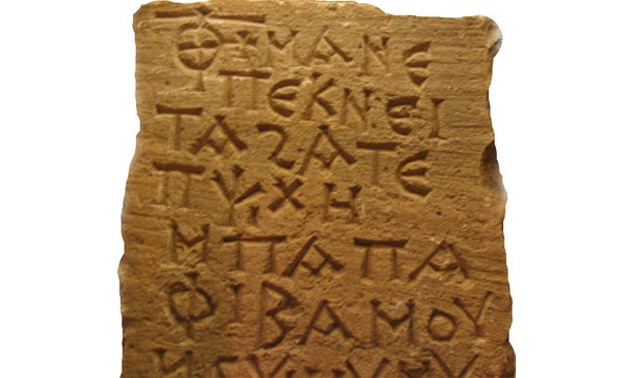
Coptic inscription, third century AD. By: Imran. Courtesy: Creative Commons via Wikimedia
CAIRO – 8 August 2017: It is fair to say that the Ancient Egyptian language is still used nowadays. “Several senior professors, popes and some villages in Upper Egypt could speak in the Coptic language as fluently as Arabic, their mother tongue,” said Michael Heshmat, lecturer at Youth Bishopric courses in Saint Mark's Coptic Orthodox Cathedral in Cairo, to Egypt Today.
The Coptic language is the final stage of the ancient Egyptian language, but it is written in the Greek alphabet, except for seven letters. The majority of Coptic words are taken from the ancient Egyptian language, with only two thousand words borrowed from Greek.
Evolution of the ancient language
The ancient Egyptian language had gone through a number of stages until it finally reached the form of the Coptic language. Ancient Egyptians developed the Hieroglyphic language, which indicated words and ideas and was used in temples and tombs. It was then simplified by temple scribes to form Hieratic, and finally Demotic was devised as normal people could not write both forms.
When the Ptolemaic Kingdom invaded Egypt, the Greek language, whose letters had their origin in the Egyptian Hieroglyphic script, influenced the ancient Egyptian language and was spread all over Egypt.
With the wide spreading of Christianity in the late second century, especially in Upper Egypt where most people could only speak Demotic and not Greek, the evangelism was in the Demotic form of the Egyptian language.
Hence, the divine books were read in Greek and translated orally into the Egyptian language, but the translation was not written due to the difficulty of Demotic and its signs, which had many pagan symbols.
When evangelists felt obliged to write the translation of divine books, they replaced the pagan symbols with Greek letters representing the same sounds, with only seven letters from Demotic for sounds that did not have equivalents in Greek, forming the language known as Coptic.
Parts of the Bible were then translated from Greek to Coptic in the first part of the third century, but the other parts were translated in the fourth century.
Like any other language, Coptic has its own literature, poetry and culture, but “we focus on learning the Coptic language only for church purposes, and hence, we do not get involved in much details of the language, such as its literature and poetry,” said Heshmat.
Its main dialects are Sahidic, Bohairic and Fayumic, which could be known through reading Coptic texts, as Coptic is the only form of the ancient Egyptian language that has vowels indicating the pronunciation of words. They extend from dialects of the ancient Egyptian language that differed according to where it was used.
The dialect used nowadays is Bohairic, but only for religious rituals in church.
The language began to disappear with the Islamic conquest of Egypt, as Arabic became the main language used in different fields of work. The Coptic language has been spoken only in church till now.
The church was then obligated to translate the Bible and prayers into Arabic due to shrinking number of people speaking the Coptic language.
Consequently, the Orthodox Church has taken several steps to revive Coptic again, as Pope Kyrillos IV, the 110th Pope of Alexandria and Patriarch of the See of St. Mark., called for Christians to donate for building a scientific institute for the Coptic language. He obligated that prayers be in the Coptic language only and appointed Priest Takla to teach Coptic to Christians.
Pope Shenouda III, the 117th Pope of Alexandria and Patriarch of the See of St. Mark, exerted many efforts to revive the language and have it be spoken and pronounced correctly. He decided to prepare lots of Coptic scientists to cooperate with foreign scientists in preserving Coptic heritage and language.
He established the Coptic Language Institute in December 1976 in Saint Mark's Coptic Orthodox Cathedral in Cairo, where Bishop Demetrius was the head of Coptic language department that taught the Coptic language, including its phonetics, grammar and script.
In addition, a range of courses in all churches are organized for teaching the language.
For example, “The Youth Bishopric course focuses greatly on the Coptic language, as the course has two levels. The first level is the preliminary stage that includes letters with their pronunciation, while the second level analyzes texts from the Bible in the Coptic language to apply what we have learned in the course,” explained Heshmat.
“People who speak the Coptic language as their native language are few, but they prove that the language still exists,” he concluded.

Comments
Leave a Comment